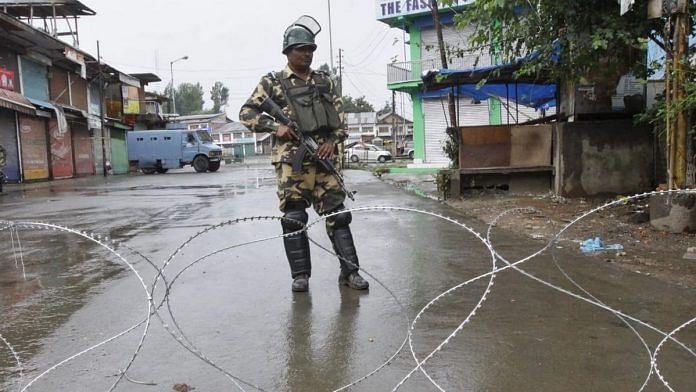Srinagar: The Jammu and Kashmir police has listed the counter-insurgency operations conducted in the Valley from the start of 2018 right up until September as one of the main factors responsible for preventing wide-scale unrest following the abrogation of the state’s special status.
An internal police assessment report has credited the killing of 388 militants in the Valley for the absence of major violent incidents in the aftermath of the Modi’s government’s decision to abrogate Article 370 that gave the state its special status.
The monthly security assessment by the J&K police has also listed as contributing factors, the massive deployment of its personnel and paramilitary forces coupled with arrests and preventive detentions.
The J&K police has also listed new counter-insurgency strategies that it employed, which, according to the force, has left militant outfits in Kashmir without organisational structures.
According to the assessment, 246 militants were killed in Kashmir division in 2018 while this year, until September, the number stands at 142. Of these 142 militants killed, 89 were gunned down in south Kashmir, considered a hotbed of the post-Burhan Wani insurgency.
Also read: Private players to be game changers as govt plans J&K projects: Governor Malik’s advisor
Most militants killed in the hinterland
According to the J&K police, each year about 40 per cent of militants are killed in areas along the Line of Control (LoC), which includes both local residents and Pakistani nationals attempting to infiltrate into the Valley.
In 2018, however, of the 246 slain militants, only 42 were “LC (Line of Control) kills”. This year, the police said, all of the 142 militants were killed in the “hinterland”.
Senior J&K police officers told ThePrint that removing the writ of militants from parts of the Valley where they operate was important as it stopped the militant outfits from mobilising people against government activities and decisions that included urban local body elections, panchayat elections, general elections, the J&K government’s Back to Village programme and the abrogation of Article 370.
“The idea was to make terror outfits operate like gangs and not organisations,” said a senior police officer requesting anonymity. “The only way to achieve this was by separating structures of terrorist organisations from their support base that includes a network of overground workers, sympathisers and new recruits,” the officer added.
“First, we went after key commanders of the Lashkar-e-Toiba, Hizbul Mujahideen and Jaish-e-Mohammad. This was followed by going after their district-level leadership,” the officer said.
“The lower rung militants and the support base became directionless because there were no instructions from previously established centralised leadership. The militants began operating in groups of 5-6.”
Among the senior militants killed in the last two years are Mehraj Bangroo, Sameer Tiger, Zeenat-ul-Islam, Azaad Dada, Naveed Jutt, Altaf Kachroo and Zakir Bhat. Police sources said the slain commanders yielded a certain influence in their area of operation that they could have used to mobilise people against the government.
There was special focus this year on the Jaish-e-Mohammad after a local militant, Adil Dar, carried out the Pulwama suicide bombing on 14 February that killed 40 CRPF personnel. According to police data, 52 Jaish militants were killed this year.
Also read: From AFSPA to street protests, Modi govt needs new thinking in J&K with Article 370 gone
‘Sympathisers’ arrested but recruitments also at a high
The J&K police assessment said that the arrests of over 700 alleged militant sympathisers have removed grassroots structures of the insurgents. This year alone, the J&K police has filed over 300 cases under the Unlawful Activities (Prevention) Act (UAPA).
But while the counter-insurgency operations have been able to inflict great damage to militants networks across Kashmir, more than 250 insurgents continue to be active in the Valley. Of these, over 150 are local residents. Last year marked the highest ever recruitment of locals (191) in over a decade, forcing militant outfits in Kashmir to reach their highest level of intake capacity.
“That was a reason that JeM revived in Kashmir,” another senior police officer told ThePrint. “Many youths who were interested in joining militancy and specifically the Hizbul Mujahideen were directed to join Jaish because Hizbul was saturated.”
While 2018 was remembered as the highest recruitment year, this year’s recruitment figures, according to police sources, are under control.
Sources told ThePrint that this year, on an average, five to six Kashmiri locals joined militant outfits each month.
“During the summer months, peak recruitment happens and this year the numbers are low,” said another senior police officer. “In June, 26 youth were believed to have joined militant outfits. In July only four and in August three youth became militants — one from Kulgam, one from Awantipora and one from Shopian.”
Another source, however, told ThePrint that security forces are probing nearly two dozen cases of youth suspected to have joined militant ranks since 5 August.
“Some of these youth left their respective homes post 5 August and have not returned,” the source said. “Some of them did return and others found to be staying at their relatives’ homes. They weren’t able to inform their families about their visit but some have still not been found. We are ascertaining their whereabouts.”
Also read: Modi has finished Pakistan’s ‘unfinished business’ of Partition






